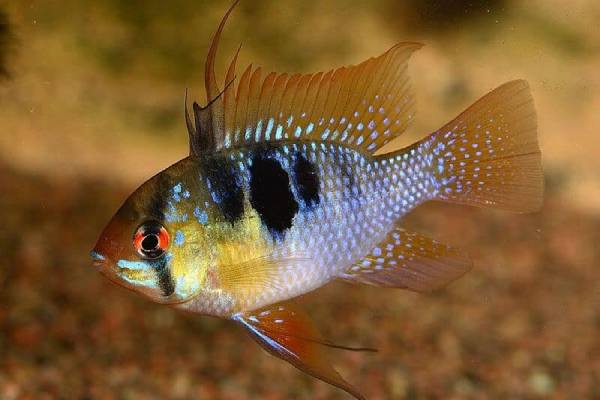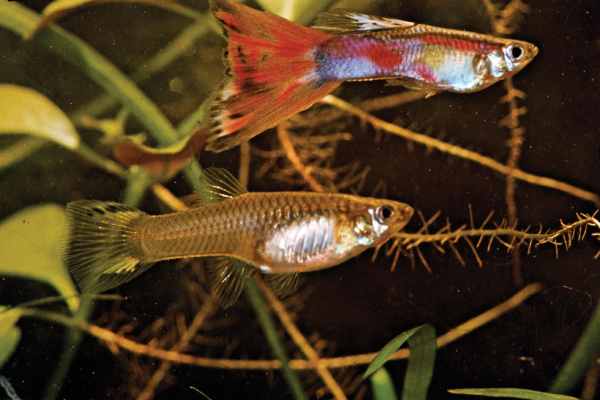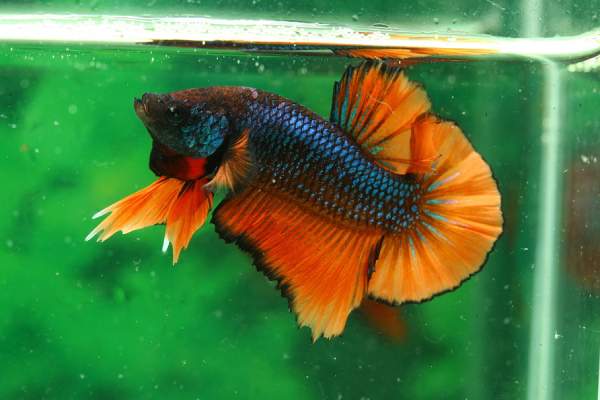Balloon Belly Ram: Care, Behavior, Breeding, Diet and Tank Mates
Balloon belly Ram is a pretty famous peaceful freshwater fish. The scientific name of Balloon Belly Ram is Mikrogeophagus ramirezi. They are a bit too difficult for beginner fish keepers. They feature a combination of beautiful hues, including a golden and blue belly color and a yellowish body tone.
By diet, they are omnivores because they eat all types of food. They need a 22 to 25 gallons tank to live, preferably. They don’t need as much space as some of their bigger cousins.
Balloon belly Ram prefers slightly acidic water, and they need 25 to 29 degrees Celcius water temperature to grow healthy. So water PH level should be between 5.5 to 7.5.

Size and Appearance of Balloon Belly Ram
Balloon Belly Ram, however, doesn’t live very long. They have a lifespan of 24 to 48 months on average. Inadequate detained breeding methods or poor farming are the main causes of early death in Balloon belly rams.
You must monitor your water parameters if you want to increase your Balloon belly Ram’s prospects. They may have shorter lives if neglected, even captured in the wild.
Let’s talk about their appearance and size.
It may not be easy to distinguish between the gender of the Balloon belly Ram. Generally speaking, females are thinner and less bright than men.
They grow up to an utmost of 4 to 5 inches.
Behaviors of Balloon Belly Ram
Balloon belly Ram is a lovely, calm, and gregarious fish that like to spend most of its time swimming in the middle and bottom of the aquarium.
However, during mating season, they might become aggressive.
Therefore, maintain a higher ratio of females to males in the aquarium to lessen regional violence.
Although they develop a territory within the aquarium, they are less aggressive than their more powerful relatives.
Even though they live peacefully with their species, as long as adequate area and safety in the tank, these fish prefer to remain to themselves.
You may keep Balloon belly Rams in couples, or they can live alone without effort. The greatest chance you have of keeping a male and female together is to let them couple up naturally. Their communities don’t respond well to pressured interactions.
These fish are clever and can identify their masters; as a result, as you approach, they often swim to the top of the aquarium in expectation of food.
Balloon Belly Ram Care
Tank Setup and Requirements
Balloon belly Rams are small compared to others, yet they need enough room to live a long, active life. Additionally, if you want to build a community, you must purchase a bigger tank according to your other fish.
Balloon belly Rams need certain tank requirements and are relatively challenging to care for since they are sensitive to water parameters. They won’t put up with trash accumulation in their tank. So be careful to equip your tank with a good filter.
Water Parameter
Balloon belly Ram needs somewhat acidic water, as we already discussed. So, the ideal range for water’s PH is 5.5 to 7.5. Having too cold water is one of the major blunders new fish keepers make with Balloon belly Rams. If the temperature falls too low, that will lower your fish’s disease resistance, and they’ll get illnesses. Therefore, your tank needs a water heater.
The water that balloon belly rams enjoy is somewhat warm. To develop healthily, they need water between 25 and 29 degrees Celsius. However, you must ensure that the other fish in your tank can withstand that temperature.
Balloon Belly Ram Tankmates
Balloon belly Rams are gentle cichlid fish that are a great addition to your social tank. But they need fellow thinkers in their tank. Therefore, tankmates should have similar tastes in the environment.
If they are partnered with bigger, more hostile fish, they will spend all their time hiding in the bushes. Therefore, stay away from fish that are loud, big, or hostile.
Some good tankmates for Balloon belly Rams are Guppies, Platies, Bolivian rams, Kuhli loaches, Corydoras, Rummy nose tetras, Clown loaches, Kuhli loach, Dwarf gouramis, neon tetra, etc.
Food
Balloon belly Rams are omnivores, although it may be challenging to encourage them to feed when initially put in an aquarium. They eat plants, small flies, and other tiny creatures in their natural habitat.
As the foundation of a Balloon belly ram’s meal, omnivore-specific retail items are suitable for your aquarium fish.
Give them time to unwind before selecting your favorite item from the menu below. Your Balloon belly Ram should eat pellets, flakes, rare green vegetables, and living and frozen items. Young Balloon belly Rams should only get food that they can consume for 3 minutes at a time. Feed them once daily. To preserve water quality, you may divide this meal into small quantities across the day.
Additionally, you should include daily servings of veggies. Be careful to remove the hard part from them, then quickly boil them before chopping them into good bite-sized chunks.
Diseases
If you don’t take proper care of your Balloon belly Ram, they will suffer from diseases like Ich, parasitic infections, skin infections, etc.
Balloon Belly Ram breeding
Balloon belly Ram breeding is not extremely challenging. The probability is that a pleasant couple will begin the procedure without your assistance.
It might take a few tries for things to work out, however.
You should build a different mating tank if you wish to increase your probability of success. Your fish may get confused by a weird day/night cycle, which might hinder effective mating.
You may use the steps listed below for mating Balloon belly Rams:
Step 1
To get the breeding couple ready for spawning, feed them a meal high in protein items.
Step 2
The dedicated breeding tank should be set up with a microfiber filter and a variety of areas for the female to deposit her eggs on. Suitable areas include broad leaves and polished pebbles.
Maintain a warm environment with a temperature of 28 to 30 degrees Celsius and a pH of 5.5 to 6.2.
Step 3
The female deposits her eggs during mating, and the male fertilizes them afterward. Usually, Balloon belly Rams watch over their eggs until they develop. Some Balloon belly Rams, nevertheless, won’t think twice about eating the eggs. Thus those types should be evacuated right away.
Step 4
Eggs hatch after three days. After that, take good care of the babies of Ballon Belly Rams.
Should You Get Balloon Belly Rams?
Balloon belly Rams are quiet, pleasant, and beautiful fish. Even if you choose one of the fish with more striking color variations, you ought not to pay a lot of money to get this fish.
Since they are sensitive to changes in the water, you must maintain steady water conditions. Only seasoned aquarists are advised to take on these adorable tiny fish because of this.
If you’re new to fishkeeping, or y our tank’s other fish are loud, hostile, or huge. I don’t suggest you add this fish to your tank.
With the right care, Balloon Belly Rams will amuse you with their vibrant coloring and amusing demeanor.
FAQs
Balloon belly ram fish is usually between 2-4 inches in size.
They can live up to 2 years and sometimes they do not exceed 24 months.
Normally they feeding them once a day is okay but you can also split their food so you feed them twice daily.



![Orange Koi Fish - Koi With Orange Markings [Pictures]](https://aquifacts.com/wp-content/uploads/2024/03/orange-koi-fish_1.jpg)

![White Koi Fish [Japanese Koi Fish Varieties]](https://aquifacts.com/wp-content/uploads/2024/03/white-koi-fish_img.jpg)
